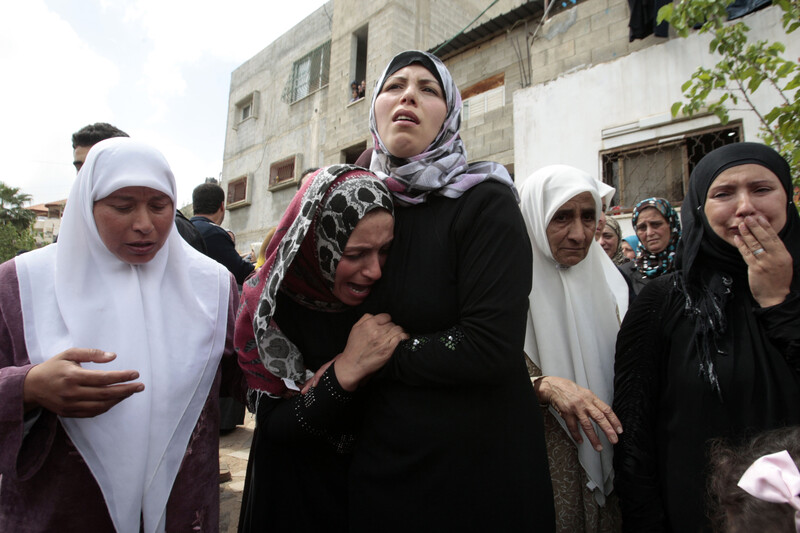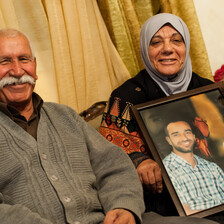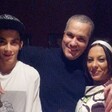The Electronic Intifada Tulkarem 10 April 2013

Relatives of cousins Amer Nasser and Naji Balbisi, killed by Israeli soldiers, grieve during their funeral in Anabta, 4 April.
APA imagesOn Wednesday last week, four young Palestinians decided to protest against the death of Palestinian prisoner Maysara Abuhamdia, a cancer patient who died of medical neglect while in Israeli custody.
Two of the young men — Amer Nassar, 17, and his cousin Naji Biblisi, 19 — were killed at an Israeli military checkpoint during the protests. Another cousin, Diaa Nassar, 18, was arrested and the fourth young man, Fadi Abu Asal, 20, managed to escape with an injury.
The four are residents of Anabta, a village near Tulkarem in the occupied West Bank. Two days after the incident, Abu Asal told The Electronic Intifada what happened. His version of events sharply contradict claims reported in the Israeli media.
Abu Asal was himself arrested by Israeli forces at his family’s home in Anabta on Tuesday, 9 April.
“Hit in the chest”
According to his account, the four walked a few kilometers from their village to the Innab checkpoint, which separates Tulkarem and Nablus, and began protesting there on the Wednesday evening.
Around 9:30pm, they saw a soldier emerging from the checkpoint. “At the same moment the shooting started, and I could not tell if it was the same soldier or another. When the shooting broke out, we started running; Amer was hit in his chest with a live bullet and fell on the ground immediately,” Abu Asal explained.
When he turned to check on Amer Nassar, Abu Asal was shot in the arm. Abu Asal and Naji Biblisi managed to run away from the checkpoint. Diaa Nassar, meanwhile, “took cover behind bricks” opposite the military watchtower and was later arrested by the soldiers, Abu Asal added.
Abu Asal and Biblisi continued running until Biblisi took a sudden turn towards the leather factory, about 500 meters from the checkpoint. Abu Asal continued running straight ahead.
“I do not recall that any of the soldiers was running after us and I do not recall that Naji got hit or showed any signs of pain or injury,” he said. Minutes later, “the shooting stopped and I managed to escape and reach the village,” Abu Asal added.
He ran three kilometers while bleeding; at 10:40pm he called for help. Abu Asal was found and taken to hospital.
“Attacked and arrested”
According to residents of the village who were close to the area, the shooting stopped sometime around 9:45pm. An eyewitness, who did not wish to be named, told The Electronic Intifada: “I saw a soldier approaching Amer’s body and stepping on his wound, which provoked Diaa to come out of his hiding place and try to protect his cousin.”
The witness added, “Diaa was then attacked and beaten by a number of soldiers, and then arrested.” Alaa Nassar, Diaa’s brother, said that “Diaa was taken to al-Jalameh interrogation center [in the northern West Bank] suffering injuries in his arm and leg.”
According to the eyewitness, Amer Nassar was “left on the ground for half an hour bleeding to death. A Palestinian ambulance was prevented from approaching him. Around 11pm, the army handed Amer’s body to the Palestinian ambulance.” As Naji Biblisi was still missing, locals began searching for him.
“At 4am, the Palestinian security forces came to the house and asked me about my son,” his mother Salimeh said. The visit by the security forces was only to confirm that Biblisi’s body was the one found in the backyard of the leather factory by the Israeli army.
“Around 4:30am, the Israeli army handed his body to the Palestinian security forces,” Salimeh Biblisi added. Naji, a gardener, was the eldest of five sons. He had dropped out of school in order to find work so that he could support his ailing father.
The Israeli media reported that Biblisi was hit by a bullet while being chased by soldiers and that his body was found only in the morning.
Killed by sniper?
Locals, however, believe that he may have been killed after the main clash and there is a high probability that a sniper fired the fatal shot. He was shot in the back with a live bullet that penetrated his chest. A large pool of blood was found beside his body. Bloodstains were not seen anywhere else between the place where his body was found and the checkpoint.
“With such a major injury, he would not have been able to walk or move except for few seconds,” explained Dr. Haytham Shadid from Thabet Thabet hospital in Tulkarem, who received the bodies of the two dead men.
The witness to the incident said “there were no soldiers running on foot after Naji and Fadi.” The witness believes that a sniper from the watchtower at the checkpoint shot Biblisi, since he saw a laser coming from the tower, which contradicts the army’s report that Biblisi was hit during a chase.
If the last shots were heard at 9:45pm, then Biblisi was more than likely shot before then. Questions remain about why his body was not handed over to the Palestinian security forces until 4:30 the next morning. Amer Nassar’s body, by contrast, was handed over about an hour after his killing.
There are also questions about whether Amer Nassar may have been left to bleed to death and whether he could have survived if medical attention was provided to him in a swift manner. The eyewitness account that a soldier stepped on his wound — and whether this was a contributory factor in his death — requires further investigation, as well.
This case highlights how Israel’s control of “information” and the lack of prompt and thorough investigations by Palestinian official bodies mean that Israel’s usually dishonest version of events is reported as fact.
The Israeli daily newspaper Haaretz reported that the army is investigating if its rules of engagement were adhered to during the incident (“IDF investigation into the killing of the two Palestinians: the observation station reported a shooting that never happened,” 4 April 2013 [in Hebrew]).
This follows a familiar pattern. When the Israeli military says it is carrying out an investigation, this is frequently interpreted as a message that journalists should wait until the probe is completed before asking further questions.
Time is of the essence here: within a few days, the media will be focused on other stories and journalists will have forgotten about the incident under “investigation.”
No autopsy
Dr. Shadid said that “the time of injury, the time of death, needs further investigation.” An autopsy report is also required, he added.
No autopsy has been carried out on Biblisi. Autopsies usually occur when the Palestinian Authority requests one, in consultation with the family of the person killed.
Yet the PA only tends to request autopsies when Israel agrees that one should be carried out or in high-profile cases — such as the recent death of Palestinian prisoner Arafat Jaradat in Israeli custody. In the Jaradat case, the PA did not release the full autopsy report; it merely announced the conclusions at a press conference.
There have been a number of other cases in which Palestinians have been killed without the causes of death being properly investigated.
For example, Muhammed al-Salaymeh from Hebron was killed by the Israeli military in December 2012. He was shot with several live ammunition bullets.
A video released by the army raised many doubts about the explanations offered by the Israeli military, but no autopsy or further investigation was conducted by the PA.
The previous month Rushdi Tamimi, from the village of Nabi Saleh, was killed by the Israeli military. He was shot with live ammunition in the back after being injured from a rubber bullet. He was declared dead at a Ramallah hospital.
The Israeli army also said then that it was investigating the case. This probe could take forever.
These cases and many others should be thoroughly investigated by Palestinian and international bodies so those responsible for killing Palestinians are held accountable.
Alaa Kanaan helped with the research for this article.
Abir Kopty is a Palestinian activist and blogger, based in Ramallah. She can be followed on Twitter @abirkopty.


